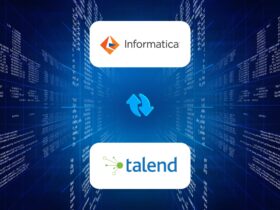Cloud Data Warehouse
Data analysis of business information, data processing, data mining, predictive analysis etc. are few of the many functions that a business enterprise follows. A specific system is used to collectively perform these functions. A data warehouse is one such system that allows you to store data from one or more sources. The ability to store current and historical data in one place allows one to perform easier data analysis and reporting.
Prior to the usage of data warehouses, large corporations had to depend on multiple systems to store similar data. Each environment of the corporation served to different users, but the data was pretty much the same. This made the process of gathering, cleaning and integrating data from various sources a tedious process. Data warehouses have provided just the right solution for these problems and has become a very critical component of business intelligence.
The advancement in the field of data warehouse is the cloud-based data warehouse. A cloud-based data warehouse is more advantageous as compared to a traditional on-premise system in many ways.
- Cloud-based data warehouse does not require a physical hardware. Hence the cost for setting up and maintaining is reduced.
- Since it is not physical, it is lot easier to scale it to handle either compute or storage requirements as necessary.
- Complex analytical queries can be performed much faster using a cloud-based data warehouse as it uses massively parallel processing (MPP).
- Cloud-based data warehouse is substantially speedier due to its usage of Extra Load Transform (ELT). With ELT, the data is immediately loaded after being extracted from the source data pools. The need of a staging database is eliminated, and the data is loaded into the single, centralized repository. The data is transformed inside the data warehouse system for use with analytics.
Given that cloud-based data warehouses have become an integral part of a business intelligence, there are a lot of advancements around this with the aim of providing better solutions. An organization can pick and choose the suitable cloud-based data warehouse based on their set of criteria.
Below are the key features of the top cloud data warehouse service providers:
- Amazon Redshift
- Best for organizations that are already using AWS tooling and deployment.
- It allows the users to directly connect with data source in the Amazon Web Services and helps in reducing the time and cost.
- Can query petabytes of structured and semi-structured data across the data warehouse and operational databases.
- Provides network isolation security.
- Google BigQuery
- Useful when the users need to analyze large data sets in cloud using standard SQL queries.
- The key factor for using BigQuery is the ability to easily query data with either SQL or Open Database Connectivity (ODBC). Thus, allowing the users to use the already existing tools.
- Microsoft Azure SQL Data Warehouse
- A petabyte-scale MPP analytical warehouse built on the foundation of SQL Server.
- The level of compute power can be scaled up, down or even paused, to reserve the amount of compute resources necessary to support the workload.
- Since it is built on MPP architecture, it enables the users to run over a hundred queries concurrently.
- IBM Db2 Warehouse
- A software-defined data warehouse for private and virtual clouds that support Docker container technology.
- IBM analytics are built directly into IMB Db2 Warehouse with multiple algorithms. This provides linear regression, decision tree clustering and more.
- The warehouse comes with integrated RStudio for development and R in-database functions, operating directly on data in a database. Thus, it helps in loading data and perform analytics in minutes.
- Oracle Autonomous Data Warehouse
- As the name suggests it is autonomous. It is a service that eliminates virtually all the complexities of operating a data warehouse and securing it.
- The automation includes provisioning, configuring, securing, tuning, scaling, patching, backing up and repairing of the data warehouse.
- It is based on the next generation cloud database platform using artificial intelligence including machine learning to deliver adaptive caching and indexing.
- Built-in machine learning technology eliminates manual configuration errors to ensure reliability.
- SAP Data Warehouse Cloud
- This is an end-to-end warehouse in the cloud that combines data management process with advanced analytics. It is built on SAP HANA and that makes it very powerful.
- It provides a new concept called Spaces which is a logical area that can be created for each line of business inside an organization. The semantics are built with the natural language index to provide specific KPI names based on the line of business(spaces).
- With the integration of SAP Analytics cloud with planning, predictive and forecasting capabilities, it is easier for business to adopt hassle-free planning and data simulation with lesser involvement of IT.
- Snowflake
- The key difference between Snowflake and the other warehouses is that it separates compute from storage. It automatically scales up and down, to get the right balance of performance vs. cost.
- One can store all the data in a single place, and size the compute accordingly. This is helpful in real time and saves a lot on the cost without sacrificing the solution goals.
- Since it allows separate storage and compute, it enables data sharing. Data can be shared with external vendors, customers or partners, even if the recipient is not a Snowflake customer.
- Snowflake partnered with Databricks to allow heavy data science and other complex workloads to run against the data.
#RandomTress #Datawarehouse








